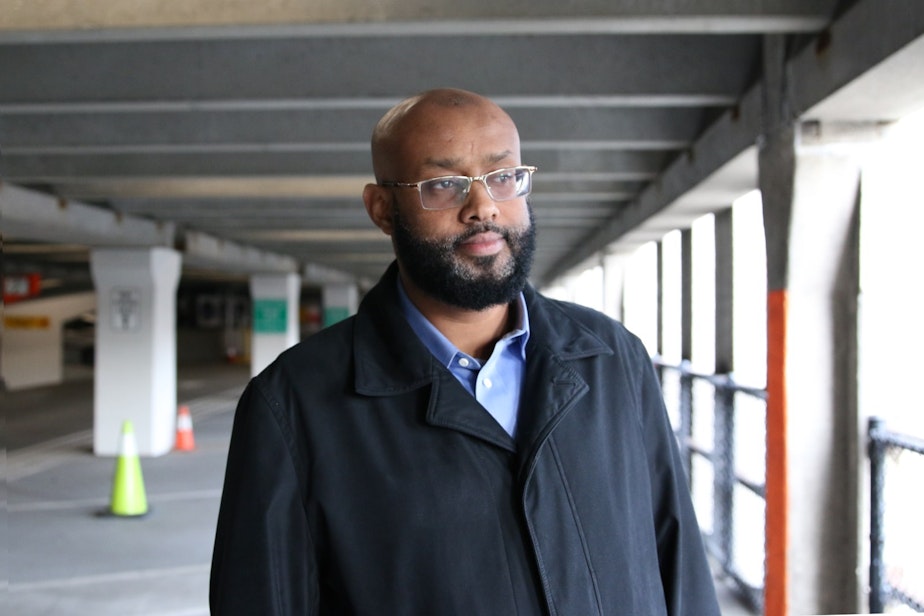Uber and Lyft drivers struggle to stay safe from coronavirus

This week rideshare drivers plan to meet with Uber and King County Health officials to hammer out a coronavirus safety plan.
Full time drivers can easily carry 15 to 20 passengers a day. Many of their customers come straight from the airport. Drivers have a lot of questions about how to stay safe.
In late January, a couple of tourists in Rome tested positive for the coronavirus. They were the first confirmed cases in Italy. By late February, the outbreak there had grown to over 600 confirmed cases.
On February 25, Derek Kaye, an Uber driver from Lake Stevens, Washington, picked up a passenger in Seattle. The passenger had come to visit Google and had just arrived from Milan, Italy.
“And he started telling me about the corona virus fallout that was happening there around Milan," Kaye recalled. "Public gatherings were shutting down. And he was saying he was kind of glad to get out of there."
"I remember him coughing into his hand in my car," Kaye said. "And I remember, after I dropped him off (he was my last rider), I took the leather wipes that I had in the car and wiped down the seats, and opened the window. But you know, I kept thinking about that rider as the news kept going on, and thinking that – he’d been right there."
A few days later, the driver developed classic COVID-19 symptoms. He tried to get tested, but couldn’t. The illness spread to his two young kids, and he turned the back half of his house into a quarantine zone.
While quarantined, Kaye learned about community transmission, and began to wonder: Was it the man from Italy, or another of his many customers who got him sick?
Kaye’s story illustrates a fear held by many Uber and Lyft drivers at this moment. The fear of getting sick, and getting others sick.
Uber made some small changes, to try to help drivers, a spokesperson told KUOW. For example, drivers can decline a customer's ride request without consequence if they suspect that person might have the virus.
Drivers are skeptical.
“I wouldn’t say it’s an effective piece of guidance, because how would the driver be able to know who is infected?" asked Ahmed Mumin, a full time Uber driver and the director of the Seattle Rider Driver Association.

Mumin said drivers need useful guidance on questions like:
- Are there some places they should not pick up passengers?
- Can a driver protect themselves by opening a window?
How should drivers handle disputes between pool customers who suspect each other of having the virus and freak out?
"Drivers aren't trained for that," Mumin said, but it's part of the job now.
- Are Uber and Lyft's carpool services safe?
- Will Uber and Lyft protect drivers’ ratings if drivers need to do something, to protect public health, that would make a customer angry?
“Like, you’re picking up somebody from downtown, and he has a lot of luggage," Mumin said. "You’re taking them to the airport. The person wants help with their luggage. You don’t want to touch their luggage. How do you handle that?”
Mumin said drivers who refuse to touch luggage for fear of contamination will likely get one star ratings. Enough of those can result in a driver getting deactivated, "which is a nice way of saying 'You're fired,'" Mumin said.
Mumin also has concerns about drivers who may hide symptoms because they can't afford to stop working. He said 90% of his member drivers do not have health insurance and they certainly don't have paid sick days.
Typhoid Mary on my mind: Coronavirus reveals thin safety net for gig workers
Uber and Lyft have been taking guidance from public health authorities, and Mumin hopes bringing all stakeholders together at a table this week will help drivers ask specific questions that aren't answered by generic guidelines.
We ran some of these Mumin's questions by Dr. Guy Palmer, an expert on emerging infectious diseases at Washington State University. He said Uber and Lyft are probably safer than a bus, because the number of people coming in contact with each other is smaller.
Opening a window probably won’t help, Palmer said, because the virus mostly spreads through contaminated surfaces.
“It’s more likely that the one individual coughs onto something, the virus is encapsulated in a droplet, and then that’s touched by the other individual.”
Palmer said drivers should use real sanitizing wipes, not a leather wipe like driver Derek Kaye had available, to wipe down things like door handles and seat belt buttons after each customer.
“The back of the seat, the headrest... Just quick wipe-downs of those would reduce the chance of transmission,” Palmer added.
If a driver must handle a customer’s luggage, wear gloves.
Driver Ahmed Mumin hopes that Uber and Lyft will provide drivers with sanitizing wipes and gloves, giving them out at airport parking lots.
“It would be sort of a safety kit for each driver,” he said.
That would keep more drivers and their customers safe, he said, so that fewer of them would have quarantine themselves like Uber driver Derek Kaye and his family.
Update Wednesday March 10:
Uber and Lyft now say they'll distribute a limited number of disinfectants.
Lyft specified what this means for them: 200,000 bottles of hand sanitizer and other cleaning supplies, starting in cities with the greatest need, which we assume includes Seattle. Lyft's supplies will be distributed from Lyft's "hubs," which are currently in 27 states.
As for driver compensation, Uber and Lyft did not promise to pay to offset the any reduction in business, but they have now promised funds for drivers quarantined for infection or other reasons by a public health agency.
Lyft specified that means up to 14 days of financial assistance, but wouldn’t say how much.
During the coronavirus outbreak, KUOW Reporter Joshua McNichols is looking for stories on how the virus is hitting vulnerable communities. If you have a story tip, write him at jmcnichols@kuow.org or via direct message on Twitter @joshuamcnichols .
___________________________________________
Dr. Guy Palmer is a Regence Professor of Pathology and Infectious Diseases, and the Senior Director of Global Health at Washington State University. He has a special interest in diseases that jump from animals to humans, such as rabies or the coronavirus.
We asked him some questions about how Uber and Lyft drivers and riders could stay safe. His answers are edited for length and clarity.
How much risk does the coronavirus pose to Uber and Lyft riders, as opposed to, say, the bus?
In the absence of clear data, you know, it's hard to put a specific risk on it. A bus is going to have obviously, many more people and many more people touching the same surfaces.
So in that context, just by the numbers of contacts, an Uber or Lyft is going to probably decrease the risk.
On the other hand, within the contained space of a car, you're within that two to four foot space that has been associated with transmission. The transmissions we've seen have tended to be very close interactions.
How these different factors influence the overall spread of this specific virus is unknown at this time.
How much risk does the coronavirus pose to Uber and Lyft drivers, relative to other kinds of workers?
Health care workers are the most at risk, of course. They're interacting closely with confirmed cases. The advantage there is they are monitored closely for signs of infection.
As for Uber drivers, there is a different risk there just because they're having more contact with more individuals. But it's unknown if those individuals are infected.
The advantage for Uber and Lyft drivers is they tend to be one-on-one or one-on-two interactions between the driver and their passengers, so it's not the same risk as larger gatherings of people. And they're in a contained space. Being in a contained space increase the chances of transmission, but it also provides them the opportunity to disinfect and keep that area clean, especially when it's a space they know and control.
Also, the fact that payment is done on the app, as opposed to passing cash or a personal credit card back and forth, as in a taxi, gives them some margin of safety.
What's the most likely way the illness could be spread, in an Uber or Lyft?
Someone coughs or sneezes, and contaminated droplets of fluid land on a surface. Someone else touches that surface, then touches their face.
How can riders avoid contamination?
While in the car, riders should avoid touching their face. It's great to say "Don't touch your face," but there's something in human nature where we touch our face a lot. You have to concentrate on not doing it.
And then, in that interval after they leave the vehicle, be very conscious about not touching their face until they've washed their hands very well.
Ideally, immediately after leaving the car, they should clean their hands with an acceptable cleanser with sufficient alcohol or Purell in it.
You recommended that drivers wipe down commonly-touched surfaces in their car, after every rider exits the vehicle. How intense of a wipe down are we talking?
Anything is better than nothing. If you get in there for a minute or two, using wipes that contain that sufficient level of alcohol or a low level of bleach, and if you just wipe down those surfaces, that really will dramatically decrease the likelihood of having live virus there.
Is that wipe-down really enough to sterilize the car?
I want to be careful about using the word "sterilized." Sterilized would indicate that we've reduced all bacteria or viruses to zero. That's not going to happen, but it's also probably not necessary. What you really want to do is wipe down those places that people are touching.
Why will opening a window not help?
We think, "Well all the air of the car is going to rush out and it's going to mix it around, and that would be good." But in fact, depending on the car and the window and how much it's open, it actually creates currents within the car that are unpredictable.
Could opening a window make it worse?
Potentially, it could. There's a small chance to inhale the virus directly.
But again, most of our concern is the surface exposure. I think that's what we should focus because that's the one thing we can control.




